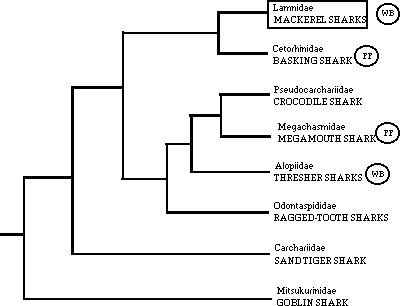Patterns in Lamnoid Evolution
For such a small group — containing only a few more than a dozen species — the lamnoids are remarkably diverse. The Goblin Shark (Mitsukurina owstoni) apparently diverged from the common ancestor of the group relatively early, becoming specialized for life in the deep-sea (though, as we shall see, not as deep as had long been thought). Possibly closer to the lamnoid common ancestor in overall form is the Sandtiger Shark (Carcharias taurus), which was probably the next lineage to diverge. Shortly after the sandtiger lineage appeared, a sizable radiation of lamnoid sharks occurred. The ragged-tooth sharks (family Odontaspididae), which are superficially similar to the Sandtiger, were the first to diverge in the wake of this radiation. This radiation also spawned the whip-tailed thresher sharks (Alopiidae), the almost-as-long-tailed Megamouth Shark (Megachasma pelagios), and the nearly symmetrical-tailed — complete with a weak lateral keel on the caudal peduncle — Crocodile Shark (Pseudocarcharias kamoharai). Another branch of that radiation gave rise to the plankton-grazing Basking Shark (Cetorhinus maximus) and the actively predaceous Great White, makos, and mackerel sharks (Lamnidae).
 It is interesting to note that filter-feeding and warm-bodiedness each
evolved twice in two separate lineages of lamnoids. Filter-feeding (FF) evolved
independently in both the Megachasmidae and Cetorhinidae, while warm-bodiedness
(WB) evolved independently in both the Alopiidae and the Lamnidae. The basic
sandtiger body form has been retained in most families (Mitsukurinidae,
Carchariidae, Odontaspididae, and Pseudocarchariidae) and been somewhat
specialized in two other long-tailed families (Megachasmidae and Alopiidae).
However, the highly specialized mackerel shark body form apparently evolved only
once, in the cetorhinid-lamnid clade. The uniqueness of the mackerel shark body
form and the persistence of the basic sandtiger form add credence to my (rather
heretical) suggestion that perhaps the extinct Mega-tooth Shark (Carcharocles
megalodon) may have more closely resembled a stocky Sandtiger than an
overgrown White Shark. But, excepting the extremely unlikely discovery of an
exceptionally well preserved or — even less likely — living specimen of megalodon,
we will probably never know for sure. Still, it's fun to speculate about.
It is interesting to note that filter-feeding and warm-bodiedness each
evolved twice in two separate lineages of lamnoids. Filter-feeding (FF) evolved
independently in both the Megachasmidae and Cetorhinidae, while warm-bodiedness
(WB) evolved independently in both the Alopiidae and the Lamnidae. The basic
sandtiger body form has been retained in most families (Mitsukurinidae,
Carchariidae, Odontaspididae, and Pseudocarchariidae) and been somewhat
specialized in two other long-tailed families (Megachasmidae and Alopiidae).
However, the highly specialized mackerel shark body form apparently evolved only
once, in the cetorhinid-lamnid clade. The uniqueness of the mackerel shark body
form and the persistence of the basic sandtiger form add credence to my (rather
heretical) suggestion that perhaps the extinct Mega-tooth Shark (Carcharocles
megalodon) may have more closely resembled a stocky Sandtiger than an
overgrown White Shark. But, excepting the extremely unlikely discovery of an
exceptionally well preserved or — even less likely — living specimen of megalodon,
we will probably never know for sure. Still, it's fun to speculate about.
